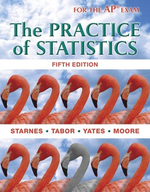Solution Found!
Men and muscle Ask young men to estimate their own degree of body muscle by choosing
Chapter 8, Problem 67(choose chapter or problem)
Ask young men to estimate their own degree of body muscle by choosing from a set of 100 photos. Then ask them to choose what they believe women prefer. The researchers know the actual degree of muscle, measured as kilograms per square meter of fat-free mass, for each of the photos. They can therefore measure the difference between what a subject thinks women prefer and the subject's own self-image. Call this difference the "muscle gap". Here are summary statistics for the muscle gap from a random sample of 200 American and European young men: \(\bar{x}=2.35\) and \(\mathrm{s}_{\mathrm{x}}=2.5\)
(a) Calculate and interpret a 95% confidence interval for the mean size of the muscle gap for the population of American and European young men.
(b) A graph of the sample data is strongly skewed to the right. Explain why this information does not invalidate the interval you calculated in part (a).
Questions & Answers
(1 Reviews)
QUESTION:
Ask young men to estimate their own degree of body muscle by choosing from a set of 100 photos. Then ask them to choose what they believe women prefer. The researchers know the actual degree of muscle, measured as kilograms per square meter of fat-free mass, for each of the photos. They can therefore measure the difference between what a subject thinks women prefer and the subject's own self-image. Call this difference the "muscle gap". Here are summary statistics for the muscle gap from a random sample of 200 American and European young men: \(\bar{x}=2.35\) and \(\mathrm{s}_{\mathrm{x}}=2.5\)
(a) Calculate and interpret a 95% confidence interval for the mean size of the muscle gap for the population of American and European young men.
(b) A graph of the sample data is strongly skewed to the right. Explain why this information does not invalidate the interval you calculated in part (a).
ANSWER:Step 1 of 5
A confidence interval (CI) is a statistical concept used to estimate the range within which a population parameter, such as the mean or proportion, is likely to fall. It provides a range of values, along with a level of confidence, that is believed to contain the true parameter.
Reviews
Review this written solution for 1055937) viewed: 1180 isbn: 9781464108730 | The Practice Of Statistics - 5 Edition - Chapter 8.3 - Problem 67
Thank you for your recent purchase on StudySoup. We invite you to provide a review below, and help us create a better product.
No thanks, I don't want to help other students
